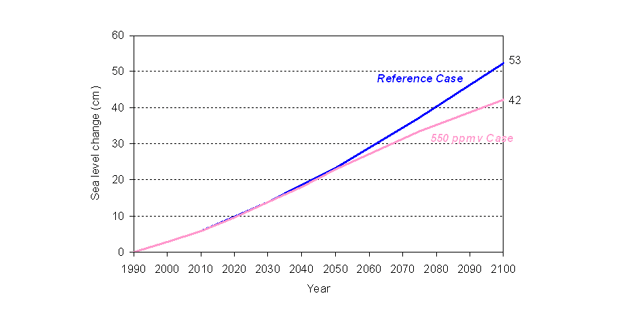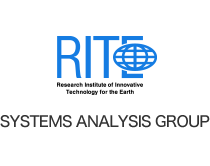Analysis Examples of Integrated Assessment Model DNE21
Model analyses in "Reference Scenario"
"New Earth 21" Program
Model analyses in "Reference Scenario"
The model analysis results can be seen here in the case of no policy-intervention for global warming mitigations.
The model analysis results are obtained by the optimization of the energy system cost, and therefore, they show the cost-effective options for the long-term and global viewpoint.
- ・Reference scenario
- ・Carbon tax scenario
- ・CO2 emission reduction
scenario - ・CO2 concentration stabilization scenario
etc.
- ・Population
- ・Reference GDP
- ・Reference final energy demands
etc.
- ・Energy resource and supply cost
- ・Energy conversion efficiency and facility cost
- ・Transportation cost of energy and CO2
- ・CO2 recovery efficiency and facility cost
- ・CO2 sequestration capacity and cost
etc.
- ・Other GHGs emissions
etc.
etc.
- ・Primary energy production
- ・Interregional transportation of energy and CO2
- ・Primary energy consumption
- ・Energy conversion and facility capacity
- ・Electricity generation and facility capacity
- ・CO2 emissions
- ・CO2 recovery and sequestration
- ・Energy price (marginal price)
- ・Marginal abatement cost of CO2
etc.
etc.
Each item of the model results in the Reference Case can be seen by a click in the figure. The results for the 10 divided world regions are obtained by this model, but the data shown here is aggregated to the world total.
Gross domestic products (GDP)
The GDP result in the Reference Case corresponds to that of the model assumption.

Analysis Examples of DNE21 - Reference Case
World final energy consumption by fuel
The final energy demands by fuel (solid, liquid, gaseous fuels and electricity) in the Reference Case correspond to those of the model assumption. The secondary energy supplies for each fuel type, e.g., solid fuels, are calculated in the model.
It is the cost-effective final energy consumption strategy that the solid fuel is supplied by coal and biomass, that the liquid fuel is by oil and little by ethanol, and that the gaseous fuel is by natural gas.
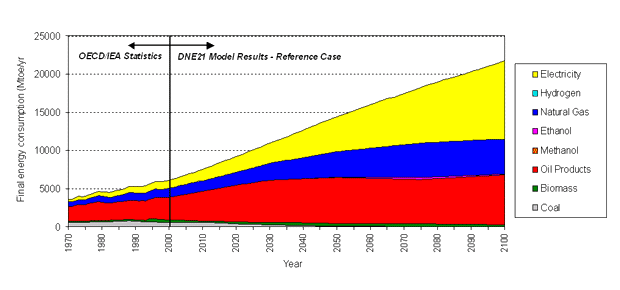
Analysis Examples of DNE21 - Reference Case
World primary energy production
The model result indicates that the increase of renewable energy use is cost-effective, but that the strong dependence on the fossil fuels is the cost-effective strategy. Growing dependence on coal is cost-effective especially after the middle of the 21st century.
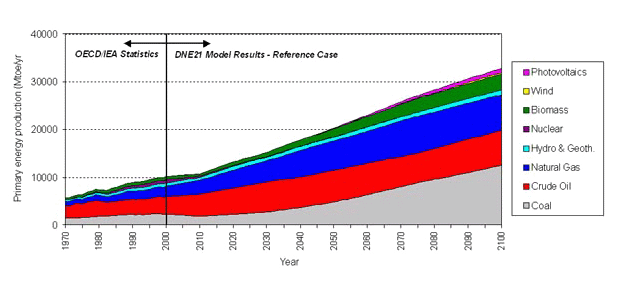
Analysis Examples of DNE21 - Reference Case
Interregional transportation of energy (net import of fossil fuels)
The most part of the oil export is from the Middle East and North Africa in 2020 and the export shares of Former USSR & Eastern Europe and Latin America increase in 2050. The model results shows that the import in the Other Asia increase in 2050.

Analysis Examples of DNE21 - Reference Case
Primary energy consumption by region
The figure below shows the cost-effective primary energy consumption by region in 2030 and 2100 in the Reference Case. The result shows that the energy consumptions in developing countries in 2100 increase drastically, and the large amounts of fossil fuels are consumed and a considerable amount of renewable energies, e.g., PV, are also used.
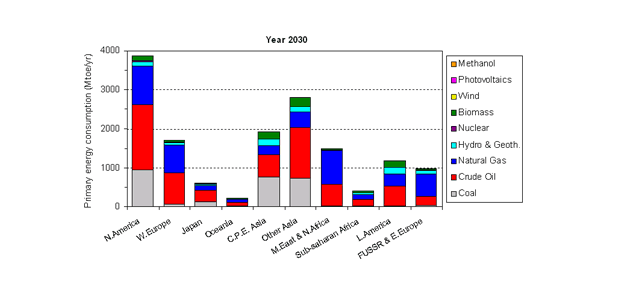
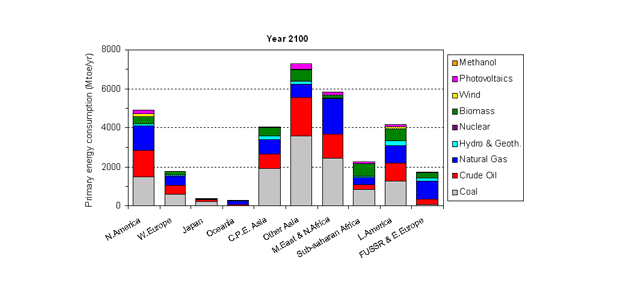
Analysis Examples of DNE21 - Reference Case
Oil refinery
The figure below shows the world total oil refineries of distillation and gasoline in the Reference Case. These expand gradually.
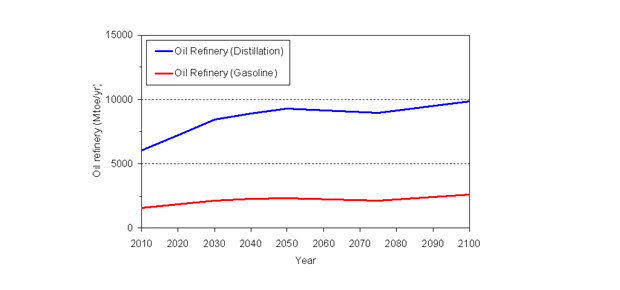
Analysis Examples of DNE21 - Reference Case
World electricity generation
The world electricity generations will be increased drastically. It is the cost-effective strategy that coal used power generations are the main role of the supply. A large amount of installation of photovoltaics, wind power and biomass power is also cost-effective, though their shares in the total supply are not so large.

Analysis Examples of DNE21 - Reference Case
CO2 emissions
Energy-related CO2 emissions in 2100 will reach at 26 GtC, which is about four times of the present level.
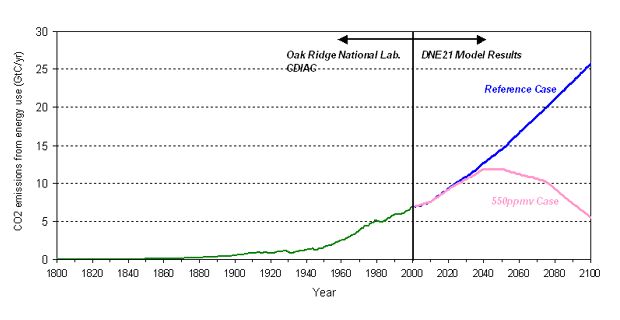
When you look at CO2 emissions by region, the emissions in developing countries will increase drastically, while emission in developed countries will not increase drastically in the 21st century. Kyoto Protocol requires only developed countries to reduce the emissions but the reduction in developing countries as well is important to reduce the world emission.
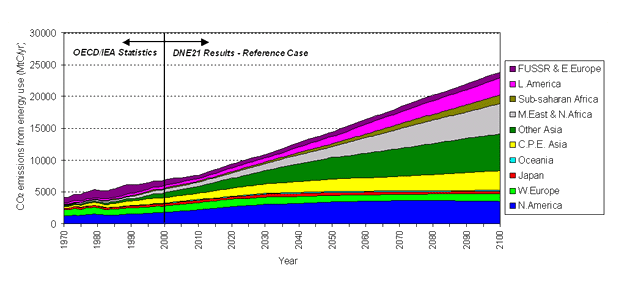
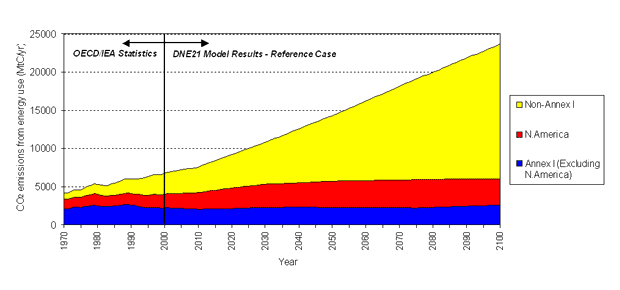
Analysis Examples of DNE21 - Reference Case
Primary energy supply price (CIF price)
The figure below shows the import energy prices (CIF price) in Japan in the Reference Case. The prices of oil and natural gas (LNG) in 2100 increase to about 400 US$/toe by the model results. On the other hand, CIF price of coal in 2100 is about 170 US$/toe.
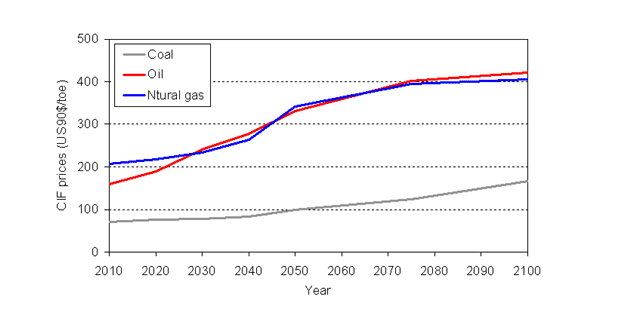
Energy price on end-use sector (electricity price)
The below figure shows the electricity prices on the end-use sector in Japan, North America and Western Europe by the model results in the Reference Case.

Analysis Examples of DNE21 - Reference Case
Atmospheric CO2 concentration
The atmospheric CO2 concentration in 2100 in the Reference Case reaches at about 740 ppmv which is the double of the present level.
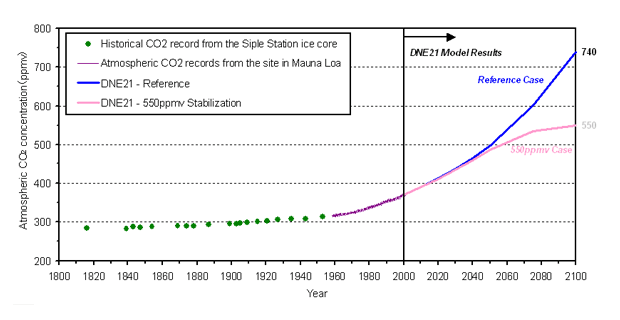
Analysis Examples of DNE21 - Reference Case
Global mean temperature change
The global mean temperature change in 2100 reaches at 3.3 degrees C (relative to the mean between 1961 and 1990) in the Reference Case.
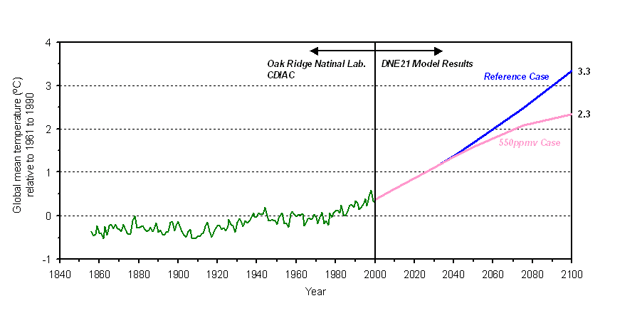
Analysis Examples of DNE21 - Reference Case
Sea level change
The sea level change in 2100 is calculated to be about 50 cm (relative to in 1990) in the Reference Case.
